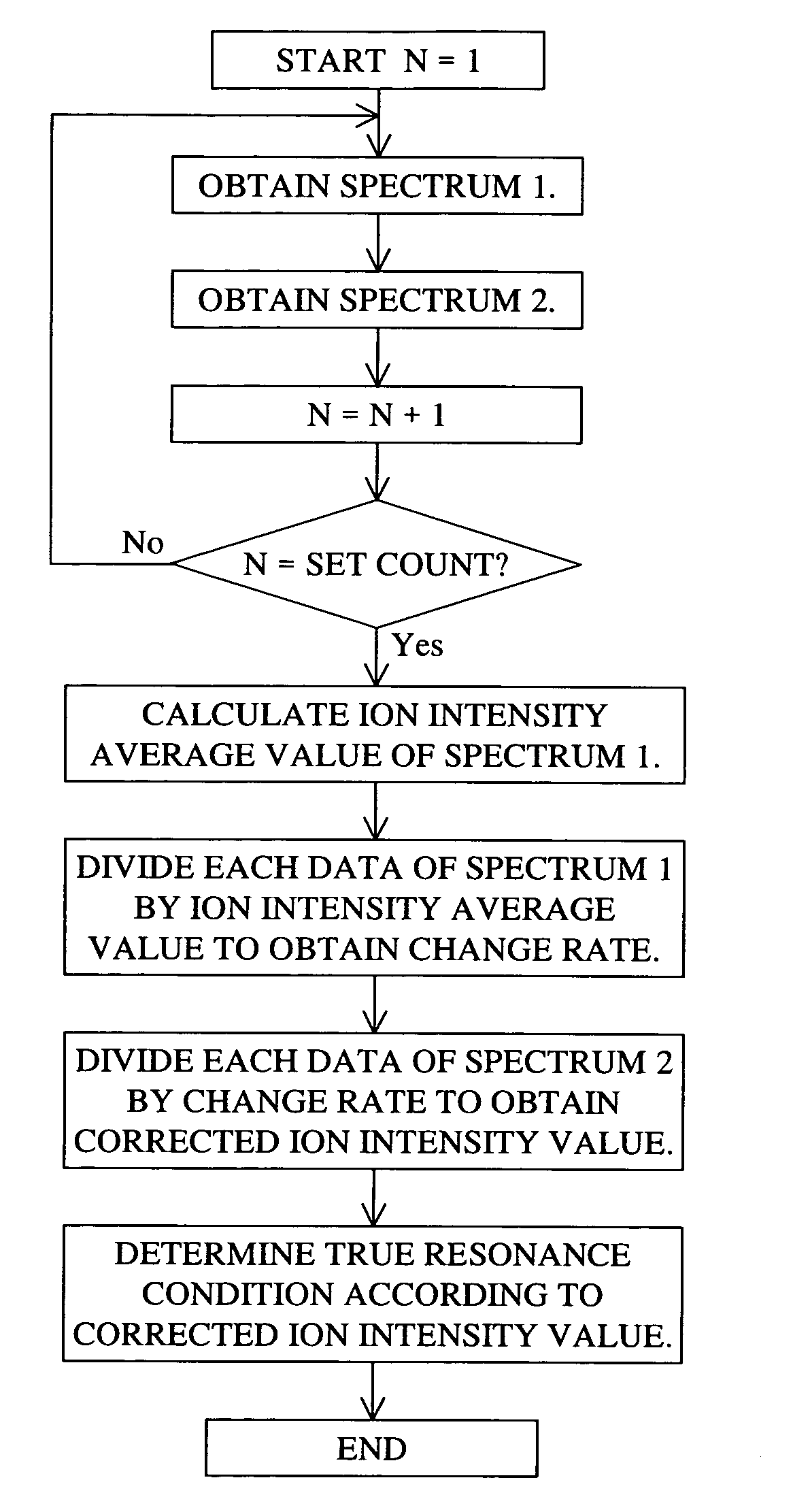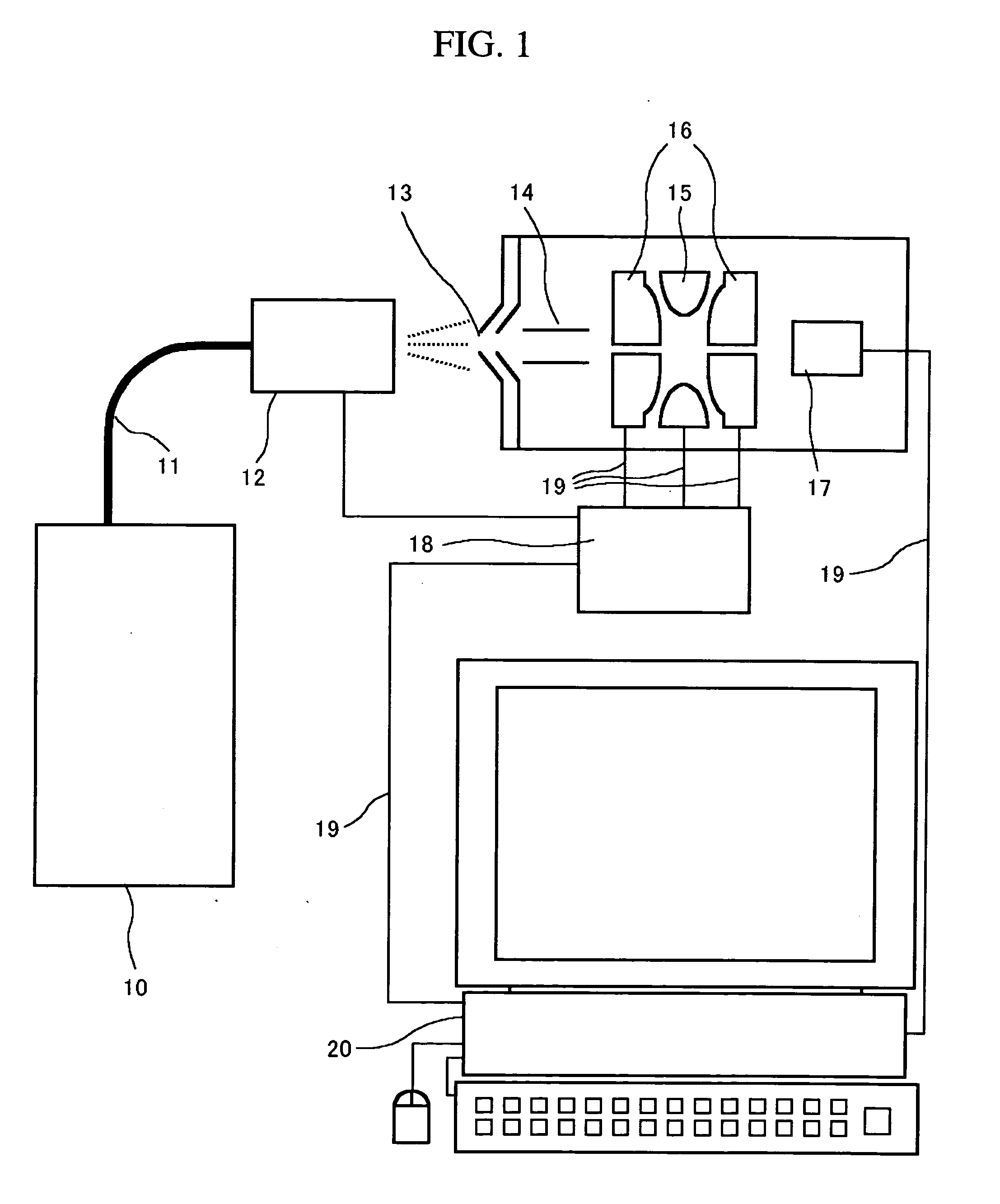Mass spectroscope and method of calibrating the same
a mass spectroscope and mass spectrometer technology, applied in the direction of calibration apparatus, separation processes, instruments, etc., can solve the problems of reducing the efficiency of ionization, difficult to keep ions stably in the ion trap, etc., and achieve the effect of high efficiency and highly reliable calibration
- Summary
- Abstract
- Description
- Claims
- Application Information
AI Technical Summary
Benefits of technology
Problems solved by technology
Method used
Image
Examples
embodiment 1
[0043] Next, a description will be made of the flow of a calibration process in the first embodiment with reference to the accompanying drawings.
[0044]FIG. 3 shows a flowchart of the first embodiment.
[0045] At first, “1” is set in the algebraical symbol N in the data processing unit 20 (or control unit 18) to start the processing. At the same time, a standard sample of which the observed mass is known in advance is caused to flow into the ion source 12 at a fixed flow rate, using the sample introducing device 10, so that the sample is ionized. This ionization of the standard sample with the known observed mass is continuously performed until the end of the calibration process.
[0046] Thereafter, a spectrum 1 is obtained. FIG. 2A shows an example of the ion trap operation to obtain the spectrum 1. As shown in FIG. 2A, an auxiliary AC voltage is not applied to the end-cap electrodes in this step. Namely, the ion trap is operated using only the main high-frequency voltage to be appli...
embodiment 2
[0056] The calibration in the first embodiment enables both the voltage applied to the ion trap and its frequency to be changed to the optimum condition. And, as a result of the calibration, graphs as shown in FIGS. 4 through 6 are displayed on the display screen of the data processing unit 20. Such a calibration result is usually stored so that the calibration reliability can be confirmed later. Alternatively, however, the information used in the calibration processing as shown in FIGS. 4 and 5 may not be stored while storing only the calibration result as shown in FIG. 6, in order to prevent an increase in the data volume.
[0057] In the first embodiment, the calibration result is obtained as shown in FIG. 6. The Y axis values of that data denote the ion intensity ratio (%) and no absolute value is recorded for the ion intensity. It is sometimes desired to know the measured ion intensity value when later referring to the calibration result. In such a case, the result shown in FIG. ...
embodiment 3
[0062]FIG. 12 shows a block diagram of a third embodiment. The third embodiment differs from the first embodiment in that a time-of-flight type mass spectroscope is disposed in a stage just after the ion trapping device. The time-of-flight type mass spectroscope is used to obtain a mass spectrum by accurately measuring the difference in time between ions when they reach a detector in accordance with their masses after they have been accelerated at the same time.
[0063] In the configuration of the mass spectroscope in this third embodiment, ions discharged from the ion trap travel through the ion transport unit 21, then they are deflected and converged through a deflector 22 and a convergence lens 23. The ions are then accelerated in the orthogonal direction by an ion acceleration unit consisting of a pushing-out electrode 24 and an extraction electrode 25. The accelerated ions are reflected by a reflectron 26, and then reach the detector 27 where they are detected.
[0064] Mass spect...
PUM
| Property | Measurement | Unit |
|---|---|---|
| mass number | aaaaa | aaaaa |
| mass spectrum | aaaaa | aaaaa |
| mass | aaaaa | aaaaa |
Abstract
Description
Claims
Application Information
 Login to View More
Login to View More - R&D
- Intellectual Property
- Life Sciences
- Materials
- Tech Scout
- Unparalleled Data Quality
- Higher Quality Content
- 60% Fewer Hallucinations
Browse by: Latest US Patents, China's latest patents, Technical Efficacy Thesaurus, Application Domain, Technology Topic, Popular Technical Reports.
© 2025 PatSnap. All rights reserved.Legal|Privacy policy|Modern Slavery Act Transparency Statement|Sitemap|About US| Contact US: help@patsnap.com



